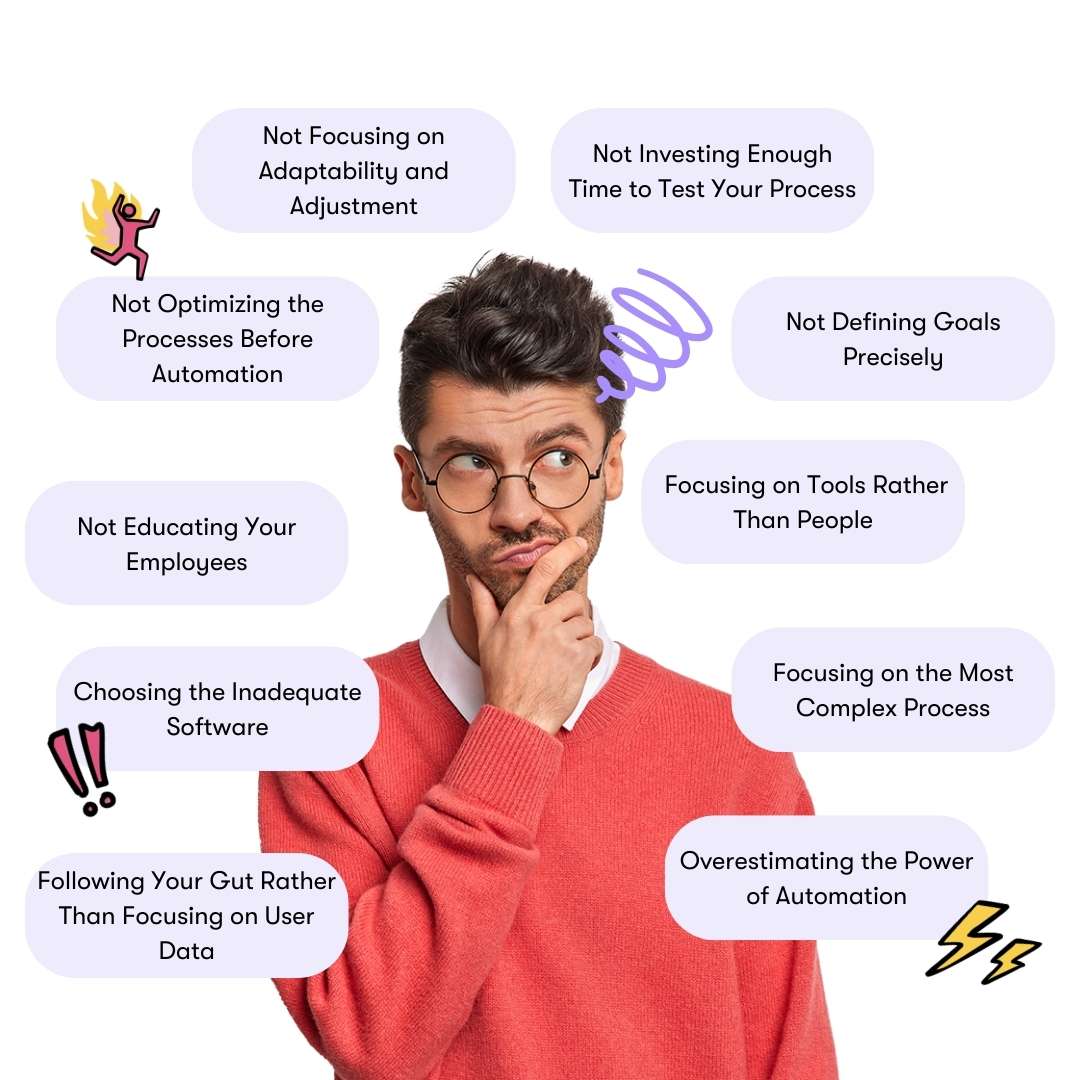Businesses worldwide are embracing automation to transform their operations, aiming to assign mundane and repetitive tasks up to automation robots while letting humans focus on more meaningful work. According to the WEF 2023 Report, 42% of of all business tasks will be automated by 2027
In their effort to automate as much as possible, businesses often oversee some details that will ultimately cost them the overall quality of the automation. Instead of automating processes and increasing efficiency, such companies often create more challenges than before automation.
Every business and process is unique and comes with a distinctive set of challenges when they need to be automated. Yet, some of these challenges are universal. So let’s explore the 10 common automation mistakes you definitely should avoid.

#1 Not Optimizing the Processes Before Automation
Every business process can be more or less effective, depending on how optimized they are. Businesses often fail to see that there’s much room for improvement, and automating such a process can only create more trouble than before. Instead of solving one problem, you’ll create two — a poorly optimized process and automation that doesn’t work.
Therefore, to get the best possible outcome from automation, it’s important to identify all steps, possible errors and inefficiencies, bottlenecks, and everything else that affects the process.
Ideally, you should check the overall efficiency of the process — does it do the thing it’s supposed to do? How well does it do it? If you can increase the efficiency before automation, then, by all means — do it.
#2 Not Focusing on Adaptability and Adjustment
The world around us evolves faster than ever, and business processes are part of it. It means the way we do business often changes, as they try to adapt to customers and other businesses. Why is this important?
The process you’re about to automate may change very soon, and you might have to tweak a couple of steps and make subsequent adjustments to it to adapt it to the latest changes.
The automated process might also stumble upon some unforeseen problems. Think how many processes were disrupted because of Covid-19. The businesses that had agility in mind when optimizing and automating their processes were able to adapt to the new way of doing business in the shortest period. Automation should be flexible to adapt to changes, ensuring businesses can quickly respond to new challenges and opportunities.
Of course, it’s impossible to foresee all issues that may occur, but being as comprehensive as possible when creating (and automating) a process always helps. The worst thing you can do is automate the process while completely disregarding flexibility.
#3 Not Defining Goals Precisely
Businesses will often reach out to automation as a solution even though their ultimate goals and goals of individual processes aren’t clearly defined. In other words, when automating processes, it’s essential to understand what kind of improvement you want to bring and how exactly you want automation to impact your processes for the better.
This is important as you’ll be able to address possible organizational changes and get a bigger picture of how automation can impact your business.
#4 Focusing on Tools Rather Than People
It’s no secret that automation tools used by businesses around the globe are more powerful than ever. Unfortunately, tools are just that — tools. They are aimed to be used by people, so instead of blindly following the tool, you’ll have to adjust it to the people who will use it. An often-overlooked automation mistake is prioritizing tools over the human element, leading to underutilized potential.
A 100kg hammer might help you nail your nails instantly, but it’s not of use if nobody can lift it. This might be an unrealistic scenario, but it paints the picture — the main goal of automation is to help people with certain tasks, so it should be designed around people and not the other way around.
Because of that, it’s often important to involve all people who’ll work with automation when optimizing and automating processes. That way, you’ll have a better idea of how to approach automation and make it convenient for your workers to use it.
This leads us to the issue below.
#5 Not Educating Your Employees
Automation is there to simplify things for workers and assist them with processes that would otherwise take much more time and money. Like every new and quickly-evolving technology (or set of technologies, in this case), automation may seem scary to workers who have no prior experience with it.
Therefore, educating everyone on what automation is and how it works is often essential to boost overall morale. Moreover, it’s important to educate employees on how to work with automation and what their roles might be in case only some parts of the process are automated.
Another issue that might arise from the lack of education is higher turnover. People who don’t understand automation’s purpose might fear losing their jobs and might start seeking alternatives. But process automation isn’t about reducing the number of employees. It’s about eliminating manual and boring tasks and making people’s lives easier as well as boosting the satisfaction of your business clients.
#6 Choosing the Inadequate Software
Automation requires using adequate software that will help you get the most out of it. However, businesses often fail to get the right software from the start, which leads to additional spending and more time setting up automation.
Therefore, it’s essential to pick the program (or rather a set of programs) that are designed specifically for your line of business and your processes. Alternatively, you can seek help from automation professionals and consult them about software (and anything else related to automation). Choosing the right software is pivotal for effective automation, as it can make or break the efficiency and success of automated processes.
#7 Focusing on the Most Complex Process Rather Than Starting with Simple Ones
Depending on your business side and the complexity of your business, you have to employ simple or complex processes to achieve your goals. More often than not, businesses consist of both simple and complex tasks, but some make the mistake of automating the latter first, which is widely regarded as a bad move.
Apart from having more steps to automate, complex business processes also require more people to be comfortable with changing how they work and ultimately verify that the automated process works properly.
Moreover, if you have no experience with automation, the chances are you might have to go through a trial and error process. Starting with a simple task to get into the swing of things and learn how to apply automation to your business is, therefore, the wisest approach.
#8 Following Your Gut Rather Than Focusing on User Data
Following your gut in businesses may sometimes prove useful, but it’s widely accepted that sticking to concrete data is the safest way to go.
The good news is that your customers will often leave some useful data that you can take into account to improve your processes. If you’re offering a digital product or service, measuring user data is easy and should be included when creating automation.
After all, apart from helping your staff, the goal of automation is to make it easy for users to get the best possible version of your product or service and achieve maximum customer satisfaction.
The main issue here is that following what your customers say may create a false picture of how to automate a certain process. However, you need to take into account that customers often say one thing and do the other, so it’s important to incorporate data for the maximum effect of your process automation.
#9 Overestimating the Power of Automation
Don’t forget that automation is just a set of tools to assist your business — it’s not omnipotent. Even though it’s rapidly evolving and helps in an increasing number of ways, automation still can only help up to a certain extent. While automation can significantly enhance operational efficiency, it's vital to maintain realistic expectations about what automation can achieve and its role as a tool to support, not replace, human decision-makings.
It’s up to you and your colleagues to come up with an optimized and effective business process in the first place to be able to automate it. If it works well while it’s completely manual and you’re aware of all challenges along the way, you can consider automating it for additional benefits.
#10 Not Investing Enough Time to Test Your Process
Setting up automation is only half the work. However, once set into motion, you might need to test the entire automated process and see how it performs. Even if some irregularities might not be available right away, they can rear their ugly head down the road, causing the automated process to be put to a halt. That’s why taking your time to test and maintain the process from time to time pays off in the long run.

Final Thoughts
Automating business processes is essential to stay competitive, but automation can only be a drawback if you fail to understand its potential and limits. Ultimately, you have to realize that automation by itself doesn’t matter much if the processes that are supposed to be automated are not as optimized as possible or your staff and customers fail to see automation benefits. Understanding the full spectrum of automation's capabilities and limitations is crucial for leveraging its benefits to the fullest, making it a cornerstone of modern business strategy.
It’s no secret that there are quite a few things to pay attention to in order to get the most from automating your business processes. That’s why it’s important to get in touch with automation professionals and get a head start.



%20and%20Business%20Process%20Management%20(BPM)-%20What%20is%20the%20difference%3F.png)










.png)